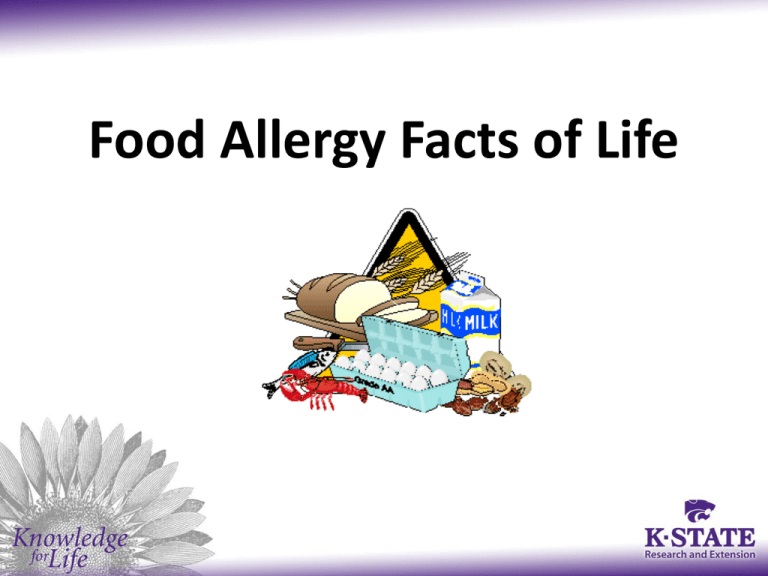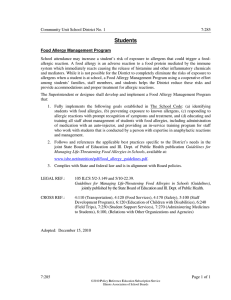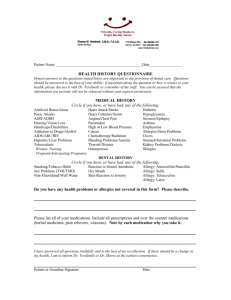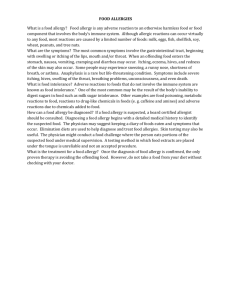Food Allergy Facts of Life
advertisement

Food Allergy Facts of Life K-State Research and Extension Golden Prairie Extension District #12 Amy Lorenzen Family and Consumer Science Food Allergy Basics The science behind it all • Our body has an immune system designed to protect us from germs and disease. • A food allergy is an abnormal response of our immune system to a food protein. • When the food is eaten, the immune system thinks the food is harmful and releases histamine and other chemicals to attack the “enemy.” Food Allergy Basics Diagnosing a Food Allergy • Detailed medical history • Allergist will conduct skin-prick tests or blood tests or both • Only way to truly diagnose if you have a food allergy Food Allergy Basics • There is no cure for food allergies • Complete and strict avoidance of the food is the only way to prevent a reaction. Food Allergy Basics • 8 foods cause 90% of the allergic reactions to people in the United States. • Each food has many different names. • Important to learn the different names of foods and read labels. Trigger Foods • • • • • • • • Eggs Fish Milk Peanuts Shellfish Soy Tree nuts (walnuts, pecans, macadamia, etc.) Wheat Food Allergy Facts • As many as 15 million Americans have a food allergy. • 9 million of those are adults • 6 million of those are children • Food allergies seem to be on the rise Symptoms-one or more may occur shortly after eating Food Allergy Basics • Symptoms: • Trouble swallowing, shortness of breath, repetitive coughing, voice change • Nausea, vomiting, diarrhea, abdominal cramping • Swelling, hives, eczema, itchy red rash • Drop in blood pressure, loss of consciousness Food Allergy Basics • Each person has a specific threshold—an amount of food that sets the allergic reaction in motion. • Tolerance level can fluctuate due to the dose, an illness or other stress in your life. • Always be aware of anaphylaxis! Anaphylaxis • A SERIOUS allergic reaction that is rapid in onset and may cause death. • Becoming aware of foods that you are allergic to is vital! Read labels! Ask! • Carry a rescue device with epinephrine. • Prompt administration of epinephrine can save your life! Managing a Food Allergy Totally avoid food allergens by: • Vigilantly reading labels and asking questions • Careful food preparation and clean up. • Always be prepared!! Label Reading A Must! • Read every label every time! • Why? Companies change ingredients all the time and don’t have to let you know. • Don’t rely on “safe” lists • Allergens can be in non-food items: shampoos, soaps, detergents, skin products medications and pet foods. Soy and its many names! • • • • • • • • Edamame Miso Natto Shoyu Soya Soy Soy Curd Soy Protein • • • • • Soy Sauce Tamari Hydrolyzed Soy Protein Tempeh Textured Vegetable Protein • Tofu • Soy Milk Careful Food Preparation • Wash hands, cooking utensils and food prep surfaces to avoid reactions from trace amounts of proteins left behind. • Liquid soap, bar soap or commercial wipes for hands, not antibacterial gel sanitizers. • Dishwashing detergent and hot water for cooking utensils and cutting boards. • Common household cleaners for counters tables and other surfaces. Always be Prepared! • Keep medications available at all times. • Know and recognize the different names for allergens. • Know and recognize the symptoms. • Food Allergy Action Plan The Three R’s • Recognize the symptoms • React quickly • Review what caused the reaction Eating Out • Be vigilant about verifying ingredients and preparation methods with your server. • DO NOT be embarrassed or afraid to tell your server about your allergies. • Call ahead to find out what is on the menu if you do not know the restaurant. Children’s Food Allergies • As a parent or caregiver, you must be extra aware of what your child eats or comes in contact with. • Distribute the Food Allergy Action Plan to all school personnel, from teachers to bus drivers. • Help your child understand the importance of his or her food allergy. Food Intolerance • Does not involve the immune system. • Produces a slow response to food, hours or possibly days after food was eaten. • Harder to identify. • Doesn’t mean it is any less stressful or troublesome to have. • Can be any food. Food Intolerance Symptoms • May be mild at first, but grow worse as time goes on. • Sensitivity to: milk, corn, wheat, eggs or some other commonly-eaten food. • Difficult to pinpoint when first started. • May not have all the symptoms. • Stress can make symptoms worse. • Can change over time. Food Intolerance Symptoms • Mouth ulcers—canker sores • Nausea and indigestion • Vomiting • Heartburn • • • • • • Internal gas or flatulence Irritable bowel symptoms Stomach pains or cramps Diarrhea Constipation Food Intolerance Identification • Food diary • Do only with physician’s guidance • Careful avoidance of food Reputable Resources • The Food Allergy and Anaphylaxis Network— foodallergy.org • Kids with Food Allergies— kidswithfoodallergies.org • The American College of Asthma and Immunology—acaai.org • National Institute of Allergy and Infectious Diseases—niaid.nih.gov Questions????? K-State Research and Extension Golden Prairie Extension District #12 Amy Lorenzen Family and Consumer Science




